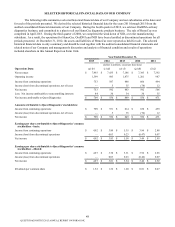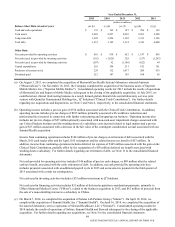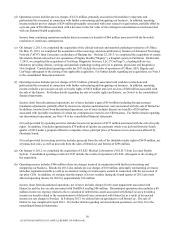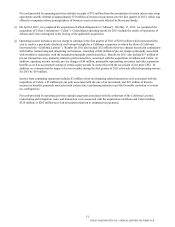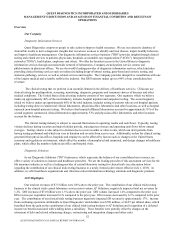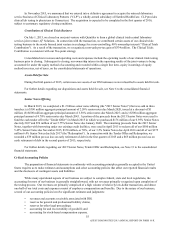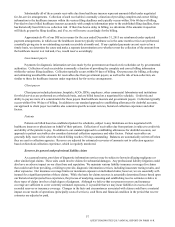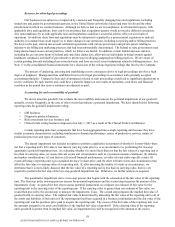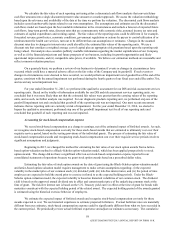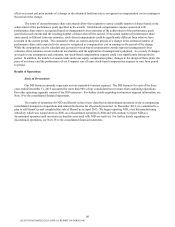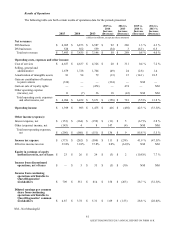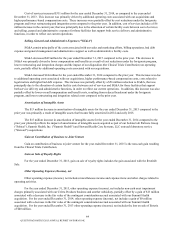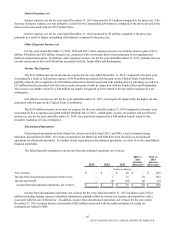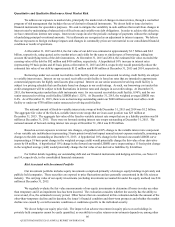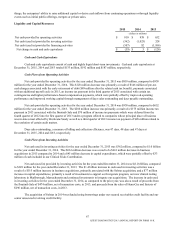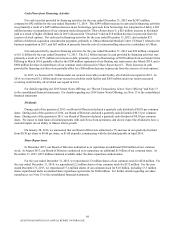Quest Diagnostics 2015 Annual Report Download - page 62
Download and view the complete annual report
Please find page 62 of the 2015 Quest Diagnostics annual report below. You can navigate through the pages in the report by either clicking on the pages listed below, or by using the keyword search tool below to find specific information within the annual report.58
Reserves for other legal proceedings
Our businesses are subject to or impacted by extensive and frequently changing laws and regulations, including
inspections and audits by governmental agencies, in the United States (at both the federal and state levels) and the other
jurisdictions in which we conduct business. Although we believe that we are in compliance, in all material respects, with
applicable laws and regulations, there can be no assurance that a regulatory agency would not reach a different conclusion.
Any noncompliance by us with applicable laws and regulations could have a material adverse effect on our results of
operations. In addition, these laws and regulations may be interpreted or applied by a prosecutorial, regulatory or judicial
authority in a manner that could require us to make changes in our operations, including our pricing and/or billing practices.
We have, in the past, entered into several settlement agreements with various government and private payers relating to
industry-wide billing and marketing practices that had been substantially discontinued. The federal or state governments may
bring claims based on our current practices, which we believe are lawful. In addition, certain federal and state statutes,
including the qui tam provisions of federal and state false claims acts, allow private individuals to bring lawsuits against
healthcare companies on behalf of government or private payers alleging inappropriate billing practices. We are aware of
certain pending lawsuits including class action lawsuits, and have received several subpoenas related to billing practices. See
Note 17 to the consolidated financial statements for a discussion of the various legal proceedings that involve the Company.
The process of analyzing, assessing and establishing reserve estimates relative to legal proceedings involves a high
degree of judgment. Management has established reserves for legal proceedings in accordance with generally accepted
accounting principles. Changes in facts and circumstances related to such proceedings could lead to significant adjustments to
reserve estimates for such matters and could have a material impact on our results of operations, cash flows and financial
condition in the period that reserve estimates are adjusted or paid.
Accounting for and recoverability of goodwill
We do not amortize goodwill, but evaluate the recoverability and measure the potential impairment of our goodwill
annually, or more frequently, in the case of other events that indicate a potential impairment. We have identified the following
reporting units for goodwill impairment testing:
• DIS business;
• Diagnostic products business;
• Risk assessment services business; and
• Clinical trials testing business (disposed of on July 1, 2015 as a result of the Clinical Trials Contribution).
Certain reporting units have components that have been aggregated into a single reporting unit because they have
similar economic characteristics, including similarities in financial performance, nature of products or services, nature of
production processes and types of customers.
The annual impairment test includes an option to perform a qualitative assessment of whether it is more-likely-than-
not that a reporting unit's fair value is less than its carrying value prior to, or as an alternative to, performing the two-step
quantitative goodwill impairment test. In evaluating whether it is more likely than not that the fair value of a reporting unit is
less than its carrying value, we assess relevant events and circumstances such as: (a) macroeconomic conditions; (b) industry
and market considerations; (c) cost factors; (d) overall financial performance; (e) other relevant entity-specific events; (f)
events affecting a reporting unit; (g) a sustained decrease in share price; and (h) other relevant events and circumstances that
affect the fair value or carrying value of a reporting unit. If, after assessing the totality of events or circumstances, we
determine that it is more-likely-than-not that the fair value of a reporting unit is less than its carrying value, then we are
required to perform the first step of the two-step goodwill impairment test. Otherwise, no further analysis is required.
The quantitative impairment test is a two-step process that begins with the estimation of the fair value of the reporting
unit. The first step in the two-step process screens for potential impairment and the second step measures the amount of the
impairment, if any. As part of the first step to assess potential impairment, we compare our estimate of fair value for the
reporting unit to the carrying value of the reporting unit. If the carrying value is greater than our estimate of fair value, we
would then proceed to the second step to measure the impairment, if any. The second step compares the implied fair value of
goodwill with its carrying value. The implied fair value is determined by allocating the fair value of the reporting unit to all of
the assets and liabilities of that unit as if the reporting unit had been acquired in a business combination and the fair value of the
reporting unit was the purchase price paid to acquire the reporting unit. The excess of the fair value of the reporting unit over
the amounts assigned to its assets and liabilities is the implied fair value of goodwill. If the carrying value of the reporting
unit's goodwill is greater than its implied fair value, an impairment loss will be recognized in the amount of the excess.
QUEST DIAGNOSTICS 2015 ANNUAL REPORT ON FORM 10-K


